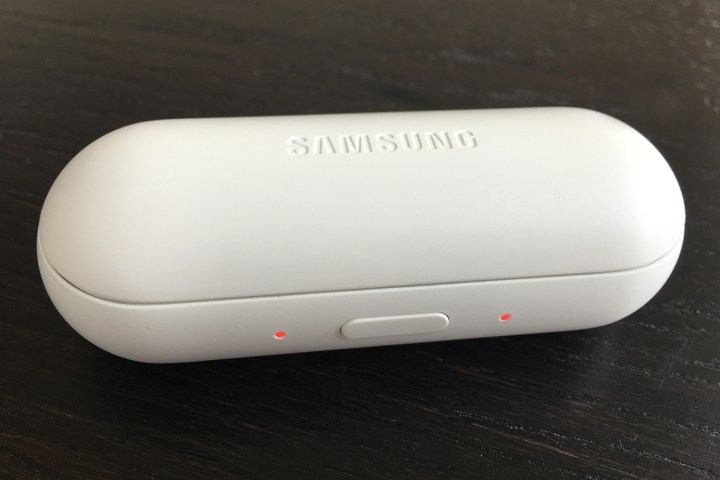Once upon a time headphones were only meant for music. These days, smart headphones that take calls, track workouts, and measure your heart rate are all the rage. Samsung is jumping on the smart earbud bandwagon with its own pair of intelligent headphones that do more than play your music.
We took the Gear IconX earbuds for a spin at a hands on demo in New York to see how well they work.
Earbuds that do much more than music
Samsung packed all the power of a Fitbit into a pair of earbuds that are much smaller than a quarter and weigh less than one, too. The Gear IconX earbuds don’t look too different from any other truly wireless earbuds you may have seen. They’re relatively small, stick snugly in your ear, and can connect to your phone via Bluetooth.
There are a couple of things that set the IconX apart, though. For starters, these earbuds have 4GB of storage built in, so that you can play all the music you want during your workout without having to be connected to your phone at all. You can even connect to your phone with them and stream Spotify, though we don’t recommend that unless you want your workout to be really short (more on that later).
These earbuds have itty bitty heart rate monitors inside and they can track all your fitness metrics.
More importantly, these earbuds have itty bitty heart rate monitors inside and they can track all your fitness metrics, including steps, calorie burn, distance traveled, and so on. When you want to see your data, you’ll need to sync them with your phone and check out your stats on S Health. You can also send the heart rate data to third-party apps, but the rest of your fitness data won’t cross over. The earbuds are essentially mini fitness trackers that sit in your ears and play music, too.
The IconX can even coach you through your workouts and let you know when you need to work harder or keep pushing on ahead. It’s like having a coach in your ear, but you can tune it out and just have your music playing if you prefer. There are touch controls on the surface of the earbuds that you can swipe to raise or lower the volume, activate the coach with a long press, and so on. The touch controls may take some practice, but they seemed easy to activate during our brief hands-on time.
The earbuds do cancel out noise. Using the mics in the earbuds, the IconX picks up ambient noise to give you awareness of your surroundings. For example, if you’re running outside, you may want to turn on ambient noise mode when you’re crossing the street.
I’m no audio expert, so I really can’t speak much on sound quality, but Samsung claims that there is no quality degradation of the music, because the IconX use two MP3 files of the same song and syncs them so that each ear hears the song at the same point. Apparently, sending sound through your brain matter is tricky, but the tracks seemed perfectly in sync when I tried them out, You won’t get the Hi-Fi audio experience with these buds, but they’re just fine, and much better than the crappy headphones your phone came with.
They fit comfortably enough in my ears. They didn’t shift or move much, though I’d like to take them on a run to make sure they actually will stay in place. Samsung provides different ear gels, though, so you should be able to find the right fit for you. The Gear IconX comes in white, blue, and black.
Battery life is its Achilles heel
It’s pretty amazing that such small earbuds can pack that much power, and the existence of the Gear IconX begs the question: Why am I wearing this bulky smartwatch/fitness tracker on my wrist? The answer, of course, is battery life. The Gear IconX can track your heart rate and activity, play music, coach you through your workout, and answer calls – but the battery will die after 3 hours … if you’re lucky.
If you’re not lucky or you happen to be streaming music from Spotify in the earbuds via a Bluetooth connection with your phone, they’ll last you about an hour. These aren’t meant for 24/7 use; they’re for a solid workout in the gym or a run outdoors. When you’re done, you pop them in their cute little pill-shaped carrying case, and they can fully charge up twice before you need to plug your case into the wall.
It’s a damn shame the battery life won’t last you through both a lengthy commute of and a long workout, or a marathon for that matter, but given the present state of battery longevity, squeezing that much juice out of earbuds this small is impressive. It’s nice to ditch the wire, and the buds feel much more natural than ones with wires. Battery tech needs to catch up.
Conclusion, availability, and price
Samsung’s IconX will cost you $200, and it’s available for purchase at various retailers including: Samsung, Amazon, Verizon, and B&H. It’s not cheap for a pair of headphones that will barely last you through your commute and an hour-long workout.
There are also a few other smart wireless earbuds out there like the Bragi Dash — which do all the same things, but cost $100 more – or the Erato Apollo 7, which cost $50 more and don’t track your fitness metrics — and you can buy those today.
Wireless earbuds that do much more than play music may be awesome, but they’re not realistic yet, as our audio expert Ryan Waniata noted in his Bragi Dash review. Hopefully Samsung’s Gear Icon X will fare better in our testing than the Bragi Dash, but even if Bluetooth works better and the touch controls prove easier to use, the limitations of battery technology will still exist.
Highs
- Comfortable to wear
- Fitness tracking and heart rate data
- Decent sound quality
- Truly wireless
Lows
- Very short 3-hour battery life
- Expensive
- Touch controls take some practice
Article originally published on June 2. Updated on 08-19-2016 by Julian Chokkattu: Added news of the IconX’s availability.





